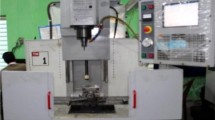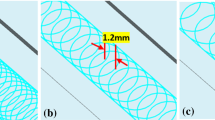Abstract
High-speed end-milling is used for production of variety of parts, dies, and molds made of hardened EN24 steel which are widely used in power and transport industries. Since desired productivity and quality are important in these industries, different strategies are needed for rough and finish end-milling operations. In this paper, a framework is presented for integrating different requirements of high-speed end-milling. In flat end-milling experiments, slots are machined in hardened EN24 steel using single insert cutter under different sets of cutting parameters for roughing and finishing operations. For rough end-milling, the responses such as material removal volume, tool wear and cutting forces are measured with respect to cutting time. A response surface is developed to predict material removal volume and a set of cutting parameters is selected for a given range of material removal volume using differential evolution (DE) algorithm till the tool wear reaches certain value. The experimental data is also used to develop Bayesian-based artificial neural network (ANN) model. Using this ANN model, reference values for cutting force and cutting time are generated for rough end-milling. Similarly, DE is used to predict a set of cutting parameters for a given range of surface roughness using response surface model. The reference cutting force is obtained for finish end-milling using ANN model. These reference values are useful in the monitoring and implementation of control strategy for the high-speed end-milling operations.
Similar content being viewed by others
References
ASM Handbook (2005) Ultra-strength steels. ASM Int 1:709–715
Chiang ST, Liu DI, Lee A, Chieng W (1995) Adaptive control optimization in end-milling using neural networks. Int J Mach Tools Manuf 34:637–660
Dewes RC, Aspinwall DK (1997) A review of ultra high speed milling of hardened steels. J Mater Process Technol 69:1–17
Dimla DE Jr, Lister PM, Leighton NJ (1997) Neural network solutions to the tool condition monitoring problem in metal cutting—a critical review of methods. Int J Mach Tools Manuf 37(9):1219–1241
Dong J, Subrahmanyam KVR, Wong YS, Hong GS, Mohanty AR (2006) Bayesian-inference-based neural networks for tool wear estimation. Int J Adv Manuf Technol 30:797–807
Elbestawi MA, Chen L, Becze CE, El-Wardany TI (1997) High speed milling of dies and molds in their hardened state. Ann CIRP 46(1):57–62
Fuh KH, Hwang RM (1997) A predicted milling force model for high-speed for high-speed end milling operation. Int J Mach Tools Manuf 37:969–979
Haber RE, Jimenez JE, Peres CR, Alique JR (2004) An investigation of tool-wear monitoring in a high speed machining process. Sensors Actuators 116:539–545
Haykin S (1994) Neural networks, a comprehensive foundation. Macmillan, New York
Jawahir IS, Balaji AK, Rouch KE, Baker JR (2003) Towards integration of hybrid models for optimized machining performance in intelligent manufacturing systems. J Mater Process Technol 139(1–3):488–498
Jemielniak K (1999) Commercial tool condition monitoring systems. Int J Adv Manuf Technol 15:711–721
Kovacic M, Balic J, Brezocnik M (2004) Evolutionary approach for cutting forces prediction in milling. J Mater Process Technol 155–156(1):1647–1652
Lee JM, Choi DK, Kim J, Chu CN (1995) Real-time tool breakage monitoring for NC milling process. Ann CIRP 44(1):59–62
Li H, Shin YC (2006) A comprehensive dynamic end milling simulation model. J Manuf Sci Eng Trans ASME 128:86–95
Liang SY, Hecker RL, Landers RG (2004) Machining process monitoring and control: the state-of-the-art. Trans ASME J Manuf Sci Eng 126(2):297–310
Liu Y, Zuo L, Wang C (1999) Intelligent adaptive control in milling processes. Int J Comp Int Manuf 12(5):453–460
MacKay DJC (1992) A practical Bayesian framework for back-propagation networks. Neural Comput 4:448–472
Mativenga PT, Hon KKB (2005) An experimental study of cutting forces in high speed end milling and implications for dynamic force modeling. Trans ASME J Manuf Sci Eng 127(2):251–259
Matlab user manual (2005) Version 7.1, R14. The Math Works Incorporation Natick, USA
Michalewicz Z, Shoenauer M (1996) Evolutionary algorithms for constrained parameter optimization problems. Evol Comput 4(1):1–32
Montgomery DC (1976) Design and analysis of experiments. John Willey and Sons, New York
Prakasvudhisarn C, Kunnapapdeelert S, Yenradee P (2009) Optimal cutting condition determination for desired surface roughness in end milling. Int J Adv Manuf Technol 41(5–6):440–451
Routara BC, Bandyopadhyay A, Sahoo P (2009) Roughness modeling and optimization in CNC end milling using response surface method: effect of workpiece material variation. Int J Adv Manuf Technol 40(11–12):1166–1180
Ryu SH, Choi DK, Chu CN (2006) Roughness and texture generation on end milled surfaces. Int J Mach Tools Manuf 46(3–4):404–412
Saikumar S, Shunmugam MS (2006) Parameter selection based on surface finish in high-speed end-milling using differential evolution. Mater Manuf Process 21(4):341–347
Saikumar S, Shunmugam MS (2011) Development of a feed rate adaption control system for high-speed rough and finish end-milling of hardened EN24 steel. Int J Adv Manuf Technol. doi:10.1007/s00170-011-3561-6
Sandvik Coromant Ltd (1999) Die and mould making application guide
Schmitz T, Davies M, Dutterer B, Ziegert J (2001) The application of high-speed CNC machining to prototype production. Int J Mach Tools Manuf 41(8):1209–1228
Schulz H, St. Hock (1995) High-speed milling of dies and moulds—cutting conditions and technology. Ann CIRP 44(1):35–38
Storn R, Price K (1997) Differential evolution—a simple and efficient heuristic for global optimization over continuous spaces. J Glob Optim 11:341–359
Tandon V, El-Mounayri H, Kishawy H (2002) NC end milling optimization using evolutionary computation. Int J Mach Tools Manuf 42(5):595–605
Toh CK (2004) Static and dynamic cutting force analysis when high speed rough milling hardened steel. Mater Des 25(1):41–50
Tolouei-Rad M, Bidhendi IM (1997) On the optimization of machining parameters for milling operations. Int J Mach Tools Manuf 37(1):1–16
Urbanski JP, Koshy P, Dewes RC, Aspinwall DK (2000) High speed machining of moulds and dies for net shape manufacture. Mater Des 21:395–402
Werthiem R (2002) Future direction for R&D in manufacturing engineering in Ireland and UK. CIRP Workshop, Dublin
Yucesan G, Xie Q, Bayoumi AE (1993) Determination of process parameters through a mechanistic force model of milling operations. Int J Mach Tools Manuf 33:627–641
Zhang JZ, Chenb JC, Kirby ED (2007) Surface roughness optimization in an end-milling operation using the Taguchi design method. J Mat Process Technol 184(1–3):233–239
Author information
Authors and Affiliations
Corresponding author
Rights and permissions
About this article
Cite this article
Saikumar, S., Shunmugam, M.S. Investigations into high-speed rough and finish end-milling of hardened EN24 steel for implementation of control strategies. Int J Adv Manuf Technol 63, 391–406 (2012). https://doi.org/10.1007/s00170-012-3915-8
Received:
Accepted:
Published:
Issue Date:
DOI: https://doi.org/10.1007/s00170-012-3915-8




